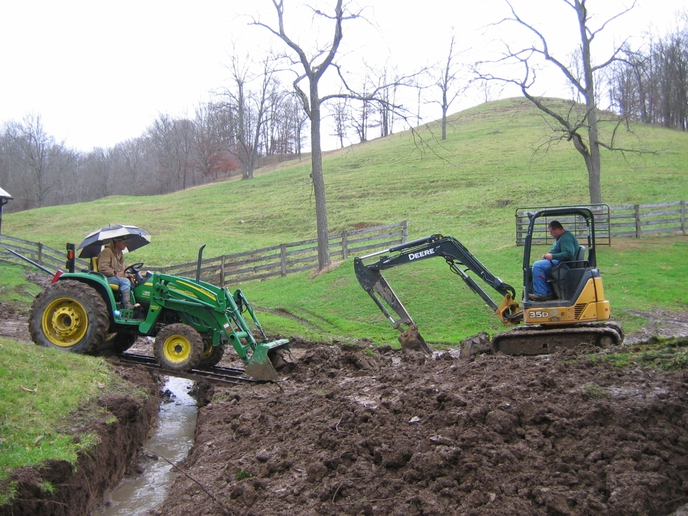Trusted Pad Construction for Your Job Demands
Trusted Pad Construction for Your Job Demands
Blog Article
Culvert Setup Facilitated: Step-by-Step Overview for Success
Setting up culverts might appear like a straightforward task, however guaranteeing a successful outcome calls for cautious planning and execution. From choosing the suitable culvert dimension to integrating correct drain steps, each action in the installment process plays an essential role in the capability and long life of the culvert system. By following a methodical approach and taking notice of key details, the installation can proceed smoothly, reducing prospective concerns down the line. Stay tuned to discover the crucial steps and considerations that can make culvert setup a smooth and effective endeavor.
Choosing the Right Culvert Dimension
Choosing the suitable culvert size is crucial for making certain reliable water circulation and structural stability in culvert installation projects - Pad Construction. The size of the culvert straight impacts the circulation ability of water with the structure. A culvert that is also tiny can lead to flooding and overflow, while one that is too large might result in reduced water velocity, potentially creating sediment buildup and blockages
To identify the ideal culvert size, factors such as the watershed location, top circulation prices, and hydraulic performance need to be very carefully thought about. Computations based upon these parameters assist in choosing a size that can sufficiently take care of the expected water quantity while lessening the risk of clogs and structural failing.
It is important to consult design standards and requirements to make sure that the selected culvert size satisfies the task demands and local guidelines (Pad Construction). By selecting the right culvert dimension, project supervisors can enhance water circulation, stop possible concerns, and improve the overall efficiency and longevity of the culvert installment
Preparing the Setup Website
Reliable culvert setup necessitates meticulous prep work of the setup website to make sure ideal architectural assistance and capability. Prior to starting the installment procedure, it is essential to remove the website of any debris, plants, or blockages that could hamper the culvert's placement. Ensuring a degree foundation is important for the proper positioning and security of the culvert. This might entail grading the website to develop a smooth, even surface area that can adequately sustain the weight of the culvert and any kind of expected loads. Furthermore, correct compaction of the dirt under the culvert is essential to protect against clearing up or moving gradually.
Additionally, it is vital to think about elements such as dirt structure, groundwater levels, and ecological impacts when preparing the setup site. Performing a detailed website analysis can aid identify any possible obstacles or risks that might impact the culvert's efficiency. By taking the time to prepare the installation website appropriately, you can aid assure an effective culvert installment that satisfies structural demands and makes sure long-lasting performance.
Positioning the Culvert Correctly

The grade at which the culvert is placed is essential for keeping an appropriate slope for water circulation. In addition, the culvert should be oriented appropriately to ensure that the inlet and outlet are in the appropriate areas. Pad Construction.
Backfilling and Condensing the Dirt
Proper backfilling and compaction of the dirt around the culvert is vital to ensure stability and stop prospective concerns in the future. When the culvert is appropriately put, the following essential action is to backfill the location around it with appropriate material. The backfill material should be complimentary from rocks, particles, and organic issue to stay clear of damage to the culvert. It is recommended to utilize granular product such as sand or gravel for backfilling, as it offers good drain and compaction residential or commercial properties.
Compaction aids in minimizing the chances of negotiation and guarantees consistent support around the culvert. It is important to small the soil evenly on all sides of the culvert to keep its structural integrity.
Correct backfilling and compaction not only offer security to the culvert however likewise aid in protecting against soil erosion and preserving the long life of the culvert system.
Guaranteeing Proper Water Drainage Assimilation
Integrating reliable drain remedies plays a critical function in the general performance and longevity of culvert setups. Appropriate water drainage integration is necessary for managing water circulation, protecting against erosion, and ensuring the architectural stability of the culvert system. To accomplish this, it is vital to create a comprehensive drain strategy that takes into consideration aspects such as the quantity of water expected, the topography of the location, and the kind of this page dirt existing.

Additionally, including features like erosion control procedures, such as riprap or vegetation, can better enhance the effectiveness of the drainage system. By thoroughly preparing and implementing these drainage remedies, culvert setups can operate successfully and withstand the examination of time.
Conclusion
To conclude, appropriate culvert installation is critical for maintaining efficient drainage systems. By selecting the ideal culvert dimension, preparing the setup site, putting the culvert appropriately, backfilling and condensing the soil, and making sure correct water drainage integration, success can be attained. Complying with these steps will certainly assist ensure the longevity and performance of the culvert, eventually contributing to the general success of the drain system.
Report this page